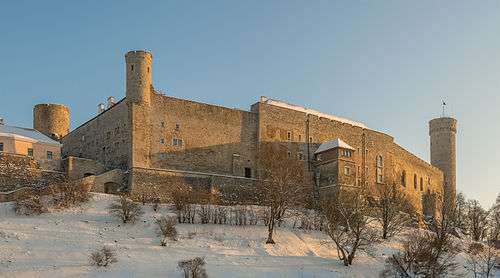Toompea Castle

Toompea Castle (Estonian: Toompea loss) is a castle on Toompea hill in the central part of Tallinn, the capital of Estonia. The castle, an ancient stronghold site in use since at least the 9th century, today houses the Parliament of Estonia.[1]
History
According to a myth, the whole hill of Toompea was made by the Linda, who built it boulder-by-boulder with her own hands. For reasons associated with this legend, Tallinn is sometimes traditionally referred to as Lyndanisse ("The nipple of Linda") in Estonian. The more prosaic truth is that settlers during the time of ancient Estonia made use of the natural hill as an easily defended stronghold. Over time, the place also developed into a commercial hub. It was probably one of the first inhabited areas of what later became Tallinn.[2]
In 1219, the castle was taken over by Danish crusaders led by Valdemar II.[1] According to a popular Danish legend, the very first flag of Denmark (Dannebrog) fell from the sky during a critical stage of the battle (known as the Battle of Lyndanisse). This first proper castle was referred to as the "Castle of the Danes", in Latin Castrum Danorum and in Estonian Taanilinnus. From the latter, the modern name of the city of Tallinn is possibly derived (see Modern name of Tallinn).
In 1227, the castle was taken over by the Order of the Brethren of the Sword, who initiated rebuilding schemes. The castle they started building is to a large extent the castle that is visible today. The castle again befell the Danes just ten years later, but was sold to the Teutonic Order in 1346, and would remain in their hands for the remainder of the Middle Ages.[1]
As the crusading Teutonic Order was a religious order, the castle came to resemble a monastery in several ways. It included a chapel, a chapter house and a dormitory for the knights. The order was also responsible for erecting the still visible towers of the church, including "Pilsticker" (translated as "arrow-sharpener"), "Stür den Kerl" ("ward off the enemy"), "Landskrone" ("crown of the land") and the probably most famous, "Pikk Hermann", ("Langer Hermann" or "Tall Hermann".[1]
Tall Hermann is 48 metres (157 ft) tall and dominates the castle skyline. The flag of Estonia is hoisted at the top of the tower every day at sunrise, to the sound of the national anthem, and lowered at sunset.[1]
With the upheavals of the Livonian War during the 16th century, the crusader orders formerly dominating the present-day Baltic states were dissolved and the region became contested by Sweden, Poland and Russia. By 1561, northern Estonia had become a Swedish dominion. The Swedes transformed the castle from a crusaders' fortress into a ceremonial and administrative centre of political power in Estonia, a purpose the castle has served ever since.[1]

In 1710, Sweden lost the territory of modern-day Estonia to the Russian Empire. The Russian administration eventually carried out large reconstruction schemes and turned the castle definitively into a palace. A new dominating wing in Baroque and Neoclassical style, designed by Johann Schultz, was added in the eastern part of the castle complex. It housed the administration of the Governorate and the living quarters of the governor. During the czarist era, a public park was also laid out to the south-east of the castle, and an archive building erected nearby.[1][3]
Following the Estonian Declaration of Independence in 1918, a building to house the parliament of the republic was erected at the site of the former convent building of the Teutonic Order. It was finished in 1922, and designed by architects Eugen Habermann and Herbert Johanson.[3] Although its exterior is traditionalist, the interior is Expressionist in style - the world's only Expressionist parliament building.[1]
See also
Bibliography
- Ruusing, Helle, ed. (2008). Toompea Castle. Riigikogu Kantslei. ISBN 978-9985-9531-7-4.
References
External links
 Media related to Toompea castle at Wikimedia Commons
Media related to Toompea castle at Wikimedia Commons
Coordinates: 59°26′08″N 24°44′14″E / 59.4356°N 24.7372°E